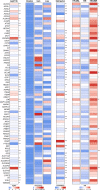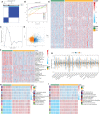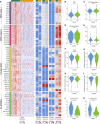The Identification and Validation of Two Heterogenous Subtypes and a Risk Signature Based on Ferroptosis in Hepatocellular Carcinoma
- PMID: 33738257
- PMCID: PMC7961086
- DOI: 10.3389/fonc.2021.619242
The Identification and Validation of Two Heterogenous Subtypes and a Risk Signature Based on Ferroptosis in Hepatocellular Carcinoma
Abstract
Background: Ferroptosis is essential for tumorigenesis and progression of hepatocellular carcinoma (HCC). The heterogeneity of ferroptosis and its relationship with tumor microenvironment (TME) have still remain elusive.
Methods: Based on 74 ferroptosis related genes (FRGs) and 3,933 HCC samples from 32 datasets, we comprehensively explored the heterogenous ferroptosis subtypes. The clinical significance, functional status, immune infiltration, immune escape mechanisms, and genomic alterations of different subtypes were further investigated.
Results: We identified and validated two heterogeneous ferroptosis subtypes: C1 was metabolismlowimmunityhigh subtype and C2 was metabolismhighimmunitylow subtype. Compared to C2, C1 owned worse prognosis, and C1 tended to occur in the patients with clinical characteristics such as younger, female, advanced stage, higher grade, vascular invasion. C1 and C2 were more sensitive to immunotherapy and sorafenib, respectively. The immune escape mechanisms of C1 might be accumulating more immunosuppressive cells, inhibitory cytokines, and immune checkpoints, while C2 was mainly associated with inferior immunogenicity, defecting in antigen presentation, and lacking leukocytes. In addition, C1 was characterized by BAP1 mutation, MYC amplification, and SCD1 methylation, while C2 was characterized by the significant alterations in cell cycle and chromatin remodeling processes. We also constructed and validated a robust and promising signature termed ferroptosis related risk score (FRRS) for assessing prognosis and immunotherapy.
Conclusion: We identified and validated two heterogeneous ferroptosis subtypes and a reliable risk signature which used to assess prognosis and immunotherapy. Our results facilitated the understood of ferroptosis as well as clinical management and precise therapy of HCC.
Keywords: ferroptosis; hepatocellular carcinoma; immunotherapy; molecular subtype; tumor microenvironment.
Copyright © 2021 Liu, Wang, Liu, Lu, Jiao, Sun and Han.
Conflict of interest statement
The authors declare that the research was conducted in the absence of any commercial or financial relationships that could be construed as a potential conflict of interest.
Figures







Similar articles
-
Identification and Validation of Ferroptosis-Related Subtypes and a Predictive Signature in Hepatocellular Carcinoma.Pharmgenomics Pers Med. 2023 Jan 26;16:39-58. doi: 10.2147/PGPM.S397892. eCollection 2023. Pharmgenomics Pers Med. 2023. PMID: 36726530 Free PMC article.
-
Hypoxia Molecular Characterization in Hepatocellular Carcinoma Identifies One Risk Signature and Two Nomograms for Clinical Management.J Oncol. 2021 Jan 20;2021:6664386. doi: 10.1155/2021/6664386. eCollection 2021. J Oncol. 2021. PMID: 33552157 Free PMC article.
-
A Ferroptosis and Pyroptosis Molecular Subtype-Related Signature Applicable for Prognosis and Immune Microenvironment Estimation in Hepatocellular Carcinoma.Front Cell Dev Biol. 2021 Nov 15;9:761839. doi: 10.3389/fcell.2021.761839. eCollection 2021. Front Cell Dev Biol. 2021. PMID: 34869350 Free PMC article.
-
A Mitophagy-Related Gene Signature for Subtype Identification and Prognosis Prediction of Hepatocellular Carcinoma.Int J Mol Sci. 2022 Oct 12;23(20):12123. doi: 10.3390/ijms232012123. Int J Mol Sci. 2022. PMID: 36292980 Free PMC article.
-
Establishment of a prognosis Prediction Model Based on Pyroptosis-Related Signatures Associated With the Immune Microenvironment and Molecular Heterogeneity in Clear Cell Renal Cell Carcinoma.Front Oncol. 2021 Nov 5;11:755212. doi: 10.3389/fonc.2021.755212. eCollection 2021. Front Oncol. 2021. PMID: 34804944 Free PMC article.
Cited by
-
The integrated landscape of eRNA in gastric cancer reveals distinct immune subtypes with prognostic and therapeutic relevance.iScience. 2022 Sep 6;25(10):105075. doi: 10.1016/j.isci.2022.105075. eCollection 2022 Oct 21. iScience. 2022. PMID: 36157578 Free PMC article.
-
Targeting ferroptosis in hepatocellular carcinoma.Hepatol Int. 2024 Feb;18(1):32-49. doi: 10.1007/s12072-023-10593-y. Epub 2023 Oct 26. Hepatol Int. 2024. PMID: 37880567 Review.
-
Derivation and Clinical Validation of a Redox-Driven Prognostic Signature for Colorectal Cancer.Front Oncol. 2021 Oct 27;11:743703. doi: 10.3389/fonc.2021.743703. eCollection 2021. Front Oncol. 2021. PMID: 34778061 Free PMC article.
-
TACE responser NDRG1 acts as a guardian against ferroptosis to drive tumorgenesis and metastasis in HCC.Biol Proced Online. 2023 May 19;25(1):13. doi: 10.1186/s12575-023-00199-x. Biol Proced Online. 2023. PMID: 37208604 Free PMC article.
-
Methylation-Driven Gene PLAU as a Potential Prognostic Marker for Differential Thyroid Carcinoma.Front Cell Dev Biol. 2022 Jan 24;10:819484. doi: 10.3389/fcell.2022.819484. eCollection 2022. Front Cell Dev Biol. 2022. PMID: 35141223 Free PMC article.
References
-
- Bruix J, Qin S, Merle P, Granito A, Huang Y-H, Bodoky G, et al. . Regorafenib for patients with hepatocellular carcinoma who progressed on sorafenib treatment (RESORCE): a randomised, double-blind, placebo-controlled, phase 3 trial. Lancet (2017) 389:56–66. 10.1016/S0140-6736(16)32453-9 - DOI - PubMed
LinkOut - more resources
Full Text Sources
Other Literature Sources
Miscellaneous

